Mastering Grilled Salmon in the Oven: A Complete Recipe Guide
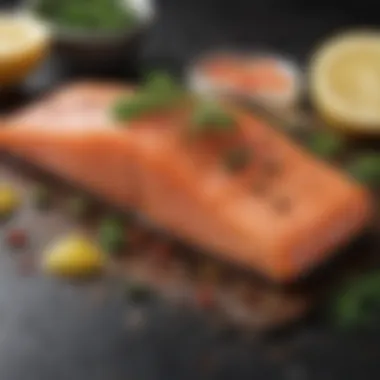
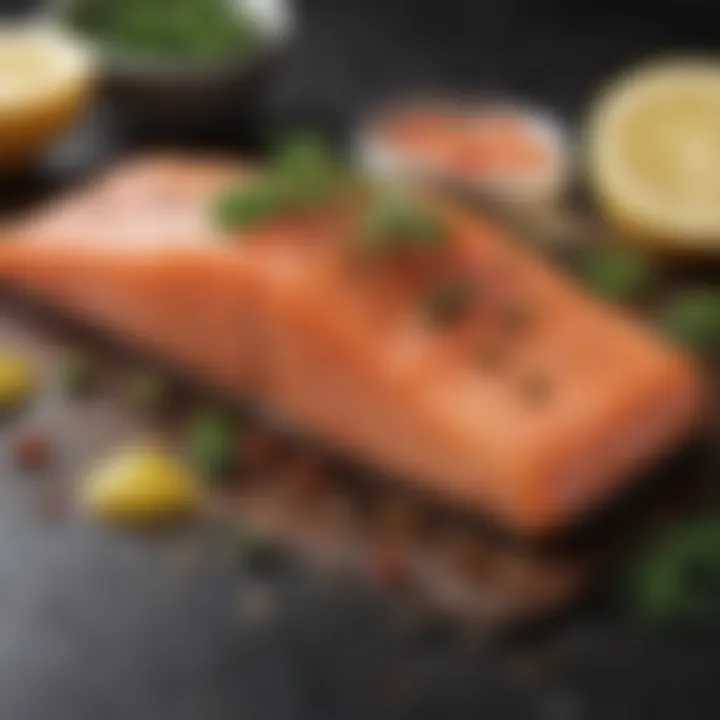
Recipe Overview
This grilled salmon recipe is not just any ordinary dish; it's a culinary delight that merges simplicity and sophistication. The name, Elegant Oven-Grilled Salmon, captures the essence of this flavorful preparation. This dish yields four generous portions, making it perfect for a small gathering or a family dinner.
The estimated time for both preparation and cooking is about 30 minutes, setting an ideal pace for those with busy lifestyles. The difficulty level is categorized as easy, allowing even beginners to create a mouth-watering dish that impresses.
Key Ingredients
- Fresh salmon fillets
- Olive oil
- Lemon juice
- Garlic, minced
- Fresh herbs like dill and parsley
- Salt and pepper to taste
Step-by-Step Instructions
Preparing Ingredients
Begin by selecting your salmon fillets. Freshness is crucial. Look for bright, moist flesh without a strong fishy odor. A good option is wild-caught salmon when available. Once selected, follow these steps for proper preparation:
- Rinse the salmon under cold water and pat dry with paper towels.
- In a mixing bowl, whisk together three tablespoons of olive oil, the juice of one lemon,two cloves of minced garlic, and fresh herbs of your choice. Season with salt and pepper as desired.
- Place the salmon in a dish and pour the marinade over. Ensure the fish is evenly coated. Allow it to marinate for about 15 minutes at room temperature for best flavor penetration.
Cooking the Dish
- Preheat your oven to 400°F (200°C). Greasing a baking dish lightly with oil is recommended to prevent sticking.
- Place the marinated salmon skin-side down in the baking dish. Reserve excess marinade in the bowl for later use.
- Bake the salmon in the preheated oven for about 12-15 minutes, depending on the thickness of the fillets. You are looking for internal temperatures of around 145°F (63°C).
- For extra zest, broil the salmon for an additional one to two minutes. This helps in brownig the top and enhancing flavors.
- Remove from the oven and use the reserved marinade to drizzle over the cooked salmon for added taste.
Time-saving Strategies
For those who often find themselves rushing, consider the following time-efficient tips:
- Prep the marinade and salmon the night before to save time when cooking.
- Use frozen, individal frozen salmon fillets, which can cook directly from the freezer with slight adjustments in cooking time.
Nutritional Information
Each serving offers a balance of vital nutrients:
- Total Calories: Approximately 350 calories per portion.
- Breakdown:
- Proteins: 34g
- Fats: 20g
- Carbohydrates: 3g
Moreover, this dish is rich in Omega-3 fatty acids, important for heart health, enlightening its nutritional value.
Quick Cooking Tips
Efficient cooking rises with a few strategic insights:
- Using Kitchen Gadgets: Air fryers can produce equally tender salmon with a shorter cooking time, providing a crispy exterior.
- Effective Multitasking: While the salmon cooks, prepare complementary servings such as a side of roasted veggies or a simple salad.
- Healthier Alternatives: Consider substituting butter with Greek yogurt in marinades for a lighter touch without compromising flavor.
Related Recipes & Variations
One of the great joys of cooking is adaptability. Here are a few suggestions to complement your grilled salmon or offer a twist to suit various dietary needs:
- Pairing with quinoa salad or grilled asparagus aligns with the elegant theme of this fish dish.
- For individuals following gluten-free diets, use a tamari-based marinade instead of soy sauce.
- Recipe variations include swapping herbs for robust spices, such as cayenne for an added kick.
Invite other culinary enthusiasts to share their adaptations of this recipe on platforms like reddit.com, or stand out on your facebook.com page, creating a community of flavor exploration!
Overview of Grilled Salmon
The dish of grilled salmon has prominent place in culinary culture, often celebrated for its flavor and versatility. Not only does it lend itself to a variety of cooking techniques, but it also serves as a blank canvas for many flavor profiles. Understanding grilled salmon is crucial for anyone wanting to appreciate this seafood dish more deeply.
Health Benefits of Salmon
Salmon is much more than just a delicious meal. Its health benefits are significant, making it a favored option for nutritious dining. Rich in omega-3 fatty acids, salmon promotes heart health and brain function. These fatty acids can lower the risk of heart disease by reducing inflammation and lowering blood pressure. Additionally, salmon is an excellent source of high-quality protein, aiding in muscle maintenance and overall health. Furthermore, it contains essential vitamins and minerals, including B vitamins, selenium, and potassium, contributing to bone health and energy metabolism.
Nutritional Profile
To fully grasp the value of including salmon in one’s diet, its nutritional profile must be examined. A standard serving of grilled salmon offers approximately:
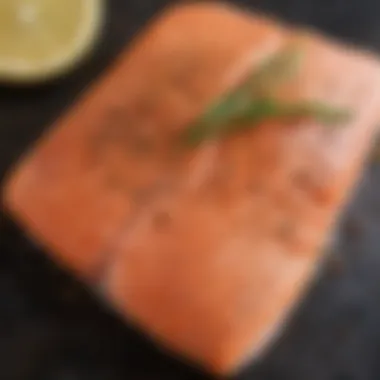
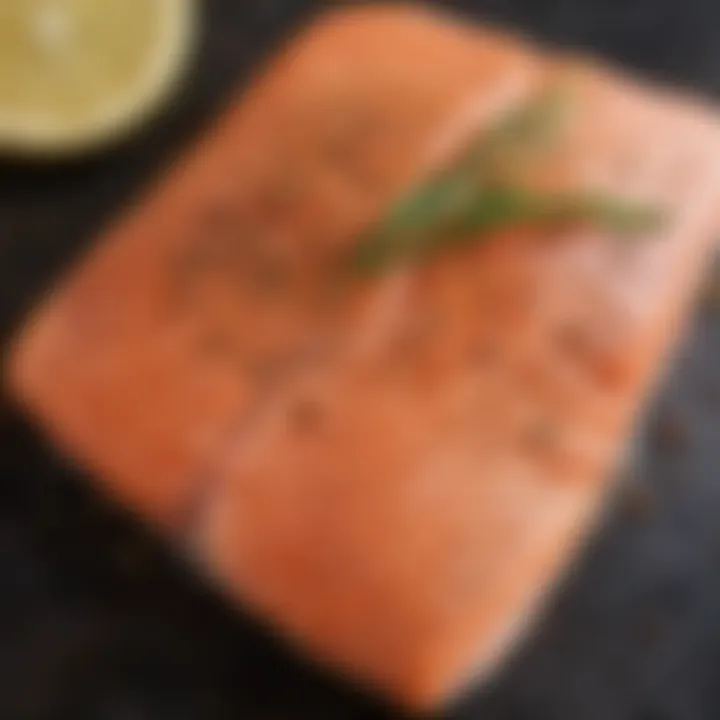
- Calories: 232
- Protein: 25 grams
- Fat: 13 grams (with omega-3 fatty acids making up a significant portion)
- Carbohydrates: 0 grams
- Vitamins: Rich in B12, B3, and Omega-3
- Minerals: Good source of selenium and potassium
The minimal carbohydrate content makes salmon an excellent fit for low-carb diets. Moreover, its diverse array of nutrients can support energy levels and enhance overall well-being. Consuming salmon regularly can contribute to meeting daily dietary recommendations, thereby motivating culinary enthusiasts to incorporate it into their meal planning.
Choosing the Right Salmon
Selecting the appropriate salmon is vital in achieving a delicious grilled dish. Different types of salmon, characterized by their sources and farming practices, can yield distinctive flavors and textures. Choice in salmon directly impacts both the culinary experience and health benefits. Learning this aspect can elevate your grilling success.
Wild-Caught vs.
Farmed
When it comes to choosing salmon, one of the primary debates focuses on wild-caught versus farmed varieties. Wild-caught salmon is typically considered superior because of its natural habitat and feeding patterns. Such salmon obtains nutrients from a diet of smaller fish and aquatic organisms, which fosters a robust flavor profile and firmer texture. It also tends to have higher omega-3 fatty acids.
In contrast, farmed salmon is raised in controlled environments, which can impact its taste and nutritional quality. Many farmed varieties are fed processed diets, which can lead to a more bland flavor. Furthermore, it is crucial to consider the farming practices. Some farms prioritize sustainability, while others use chemicals and antibiotics that may raise health concerns. Although farmed salmon offers consistency in supply and usually lower prices, discerning cooks often prefer the freshness and flavor of wild-caught.
Choosing salmon is not just about taste; it is also about nutrients and ecosystem impacts. Selecting wisely benefits your health and promotes responsible consumption.
Sustainability Considerations
The aspect of sustainability cannot be underestimated when choosing salmon. As overfishing remains a significant global issue, considering the origin of your salmon is crucial. Sustainable fishing practices help maintain fish populations and ecosystems, thus assuring availability for future generations.
Labels such as MSC (Marine Stewardship Council) or ASC (Aquaculture Stewardship Council) can provide insights into sustainable sourcing. These certifications indicate adherence to high standards in responsible fishing or farming. Both options provide benefits; however, you should evaluate environmental impacts. Those who support sustainable fisheries often opt for wild-caught. Meanwhile, sustainable farms continue developing methods to fruition without harmful practices.
This decision-making process not only contributes to environmental conservation but also often delivers higher quality salmon on your plate. Taking these factors into account ensures that you enjoy a top-notch grilling experience while being responsible about food choices.
Essential Ingredients
Essential ingredients play a vital role in preparing a delicious grilled salmon dish. The quality and freshness of each component significantly impacts the overall flavor and appeal of the meal. Ingredients not only contribute taste but also align with nutritional benefits, making the final presentation a balance of flavor and health.
Basic Ingredients for Grilled Salmon
The primary staple required in a salmon recipe is, of course, salmon itself. While choosing salmon fillets, freshness should be a priority. Look for vibrant color and moist texture. Recommended types include sockeye and king salmon which are known for their rich flavor. Moreover, using ingredients like olive oil, salt, and pepper is essential for achieving a baseline taste that supports the inherent qualities of the fish.
Additional ingredients such as garlic and lemon can elevate the final dish. Besides enhancing flavor, these add fresh aroma, providing a compelling experience that appeals to the senses. Fresh herbs like dill can enhance flavor profile while adding color to the dish.
Marinades and Seasonings
Marinades and seasonings are instrumental in shaping the final profile of grilled salmon. They allow ingredients to permeate the fish, introducing layers of taste that enhance satisfaction during the meal. Well-crafted marinades highlight the fish's natural attributes while providing a round taste experience.
Common Marinade Ingredients
Common marinade ingredients usually include soy sauce, honey, and mustard. Soy sauce brings saltiness and umami depth, while honey adds sweetness. Mustard serves as a point of acidity, balancing the contrasting flavors. These ingredients blend seamlessly, promoting a harmonious flavor. Such marinades are beneficial as they penetrate the salmon, ensuring flavorful bites from the first to the last piece.
One downside of certain marinades is the risk of overpowering the salmon's natural taste. It is crucial to strike an energy between highlighting the salmon and allowing its unique flavor to shine.
Flavor Combinations
Creating the right flavor combinations is key to crafting an enjoyable dish. Classic pairings include lemon with fresh herbs or garlic with honey. These combinations not only blend well but also promote beneficial chemistry between salty, sweet, and acid components.
The advantage of multiple flavor combinations lies in the diversity they bring. They offer ways to personalize grilled salmon based on desired taste cravings, encouraging creativity while being simple. However, it is essential to ensure the combination does not overshadow the fish, as each component needs to contribute to a balanced outcome.
Freshness maintains the integrity of any dish; the closer to natural, the better the flavor experience of grilled salmon will be.
Thus, understanding these components serves as a cornerstone in crafting an exemplary grilled salmon in the oven.
Preparation Steps
Preparation steps are vital in ensuring the grilled salmon turns out both flavorful and correctly cooked. These steps facilitate executing the recipe without anything feeling rushed or chaotic. A well-prepared kitchen allows for smoother cooking and often leads to better results. Attention to detail in preparation helps avoid mistakes that might occur later.
Thawing Frozen Salmon
Thawing frozen salmon properly is a fundamental first step. Salmon should ideally be thawed in the refrigerator overnight. This method allows the fish to retain its texture and prevents bacteria growth during thawing. If time is limited, submerging the salmon in a sealed bag in cold water for about an hour works as a rapid alternative.
It is crucial to avoid thawing salmon in warm water, as it can create uneven temperature and bacterial growth. Once thawed, make sure to pat the fish dry before marinating or cooking. Removing excess moisture helps the seasonings adhere well, promoting better flavor absorption.


Marinating Techniques
Marinating salmon adds layers of flavor and can elevate the dish significantly. Marinating should be approached with care; the most common time frame is between 30 minutes to two hours. For a simple marinade, a mixture of olive oil, lemon juice, salt, and pepper provides excellent results. Alternatively, exploring specific flavors like garlic, fresh herbs, or soy sauce can make a distinct impact on the fish’s taste profile.
When using acidic ingredients, monitoring the marinating time is essential. Over-marinating can lead to a change in texture, making the fish mushy. Consider various eficaz flavor combinations with herbs like dill or parsley to find the perfect match tailored to personal preference.
Prepping the Baking Sheet
The baking sheet preparation sets the stage for even cooking. Start by lining the sheet with parchment paper or aluminum foil. This not only prevents sticking but also offers an easy cleanup. Next, use a light layer of oil on the surface. Simply brushing the oil helps convey heat and moisture content evenly, preventing the salmon from drying out.
An important detail is to arrange the salmon pieces spacing them out comfortably. This helps to ensure balanced cooking and efficient heat circulation. Ultimately, taking the time to prepare the baking sheet contributes to consistent cooking results. Taking shortcuts at this stage may lead to undesired texture and cooking inconsistencies.
Proper hydration and minimal touching are pivotal to guarantee you achieve the greatest culinary prowess.
Oven Grilling Methods
Understanding oven grilling methods is vital for achieving the desired results when preparing grilled salmon. Grilling in the oven can offer versatility, allowing cooks to replicate outdoor grilling techniques within the comforts of their kitchen. The choice of method significantly affects the flavor, texture, and overall presentation of the salmon. Therefore, being knowledgeable about broiling and baking techniques is essential.
Broiling Techniques
Broiling is one popular method that simulates the high heat of a traditional grill. In this dymamic process, salmon is positioned under the broiler, which distributes intense heat from above. This method is particularly helpful for developing a desirable crust on the outside while keeping the inside flaky and moist. Key factors to consider include:
- Preparation: Placing the salmon on an oven-safe dish, ideally lined with aluminum foil for easy cleanup, is essential.
- Distance: The salmon should be set about 4-6 inches from the heat source, which allows even cooking.
- Monitoring: Keep a close eye on the cooking process as broiling can create rapid changes in both color and doneness.
Using these techniques, you can produce a flavorful experience that stands out.
Baking Techniques
Baking salmon, on the other hand, offers a different approach by cooking the fish in a controlled environment at a sustained temperature. This allows for more consistent cooking across the thickness of the fillet. Closed or covered options enhance the flavors meld through steam, preventing the meat from drying out. Key considerations for baking salmon include:
- Temperature Setting: Typically, setting the oven to 350 to 400 degrees Fahrenheit is recommended.
- Foil or Dish: Wrapping the salmon in foil with seasonings seals in moisture or placing it directly in a baking dish for an open-cooking style.
- Cooking Time: The general rule is to bake salmon for approximately 20 minutes per inch of thickness, which allows for a juicy outcome.
With these methods, salmon can easily retain its unique flavor while taking on any marinated notes you add.
Temperature and Timing
Getting the right temperature and timing is crucial to successful salmon means. When preparing grilled salmon in the oven, a few best practice examples include:
- Internal Temperature: Cooked salmon should reach an internal temperature of 145 degrees Fahrenheit to ensure safety.
- Estimation: As a baseline, salmon fillets typically cook for around 12 to 15 minutes for average-sized portions when using the broiling method.
- Resting Period: Removing salmon from the oven and allowing it to rest for a few minutes allows the juices to redistribute throughout the fillet.
Accurate monitoring of both temperature and time ensures that every salmon fillet exits the oven perfectly cooked.
Mastering these methods builds a strong foundation for grilling salmon inquiries any cook might encounter. These techniques open up practical possibilities to enhance the nutrition and taste on any dining table.
Common Mistakes to Avoid
When preparing grilled salmon, avoiding common mistakes is essential for achieving a great flavor and texture. By understanding these pitfalls, you can significantly enhance the quality of your dish. Focused attention on detail will allow you to perfect your technique, making the experience more rewarding.
Overcooking the Salmon
Overcooking salmon is one of the most frequent errors encountered during preparation. This mistake can lead to a dry and unpalatable result. Salmon is delicate fish, requiring swift and precise cooking. Overheating strips it of natural moisture and flavor, resulting in a subpar dining experience.
To prevent overcooking, monitor the cooking time closely. On average, salmon cooks for about 12 to 15 minutes in the oven, but timing might vary based on pieces’ thickness. The rule of thumb is to cook salmon for 4 to 6 minutes per half-inch of thickness.
Another reliable method to assess doneness is to use an instant-read thermometer. The FDA recommends an internal temperature of 145°F for cooked salmon. Furthermore, salmon should remain slightly pink in the center, gently flaking yet still moist. This behavior shows that the fish has not been overcooked, aiding in retaining its rich flavors.
One important tip is to allow the salmon to rest for 5 to 7 minutes after taking it out of the oven. This helps prevent the fish from further cooking while resting.
Using Inadequate Seasoning
Seasoning is vital to elevate the dish, yet many individuals either under-season or neglect proper flavors. Salmon has a subtle taste on its own. Adequate seasoning is essential to enhance its rich flavor profile. Failing to properly season the fish can lead to a bland result, disappointing expectations.
Consider using a mix of salt, pepper, herbs, and spices. For those who are more adventurous, marinades can infuse impressive flavors. Ingredients such as garlic, lemon juice, dill, and ginger can elevate the overall taste when combined thoughtfully.
It's also worth noting that the marinating time should align with the recipe's seasoning. Aim for at least 30 minutes to several hours, allowing flavors to seep in, but not overnight, as too much time can lead to changes in texture.
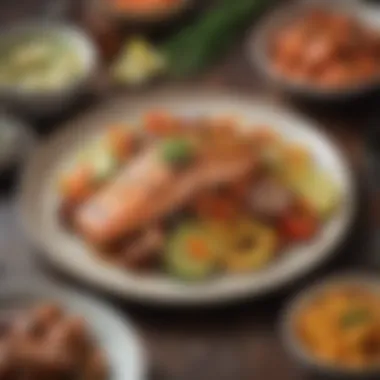
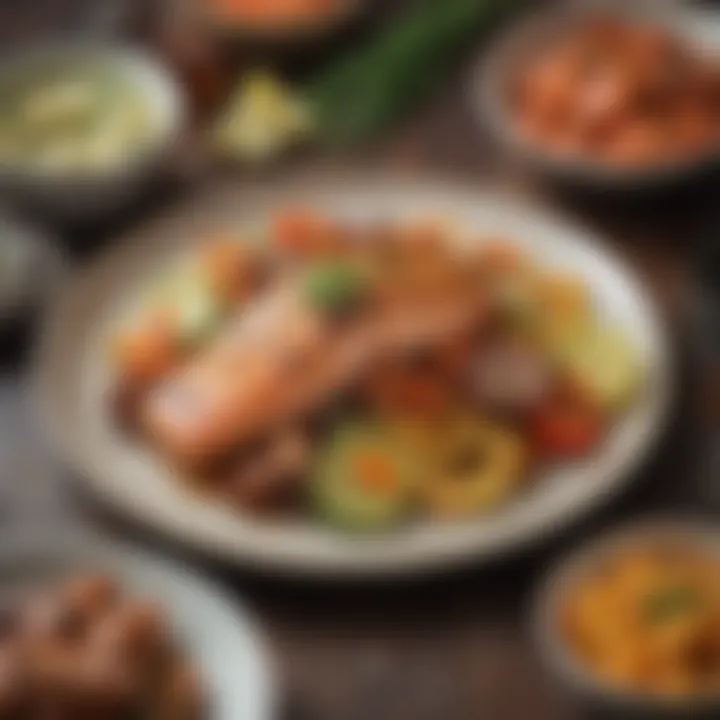
In summary, both overcooking salmon and inadequate seasoning can considerably detract from your homemade efforts. Learning to navigate these common mistakes ensures your grilled salmon recipe shines with optimal texture and flavor. You can truly enjoy the elevated experience with careful planning.
Serving Suggestions
Serving suggestions play a pivotal role in enhancing the dining experience of grilled salmon. It is not just about the main dish; what accompanies salmon can elevate its flavor profile and add nutritional balance. Recognizing this, various side options with contrasting textures and aromas create a meal that is not only visually pleasing but also satisfying to the palate. The right accompaniments can enrich the meal, making it memorable.
Complementary Side Dishes
Vegetable Pairings
Vegetables are th essential companion to grilled salmon for several reasons. They not only bring color to the plate but also provide a range of flavor dimensions. Suitable options include asparagus, green beans, and broccoli that offer both flavor and nutrients.
- Colorful Creativity: Using vibrant vegetables like bell peppers and zucchini can enhance the visual appeal of the dish.
- Nutritional Boost: They're loaded with vitamins and minerals that complement the healthy profile of salmon.
- Light and Fresh: Choosing lighter sides ensures the main dish retains focus; this avoids overwhelming taste buds.
Unlike starchy options, vegetables with lower carbohydrates can support a leaner meal that's great for those mindful of their dietary intake.
Grain Options
Incorporating grains can offer a hearty contrast to the flaky structure of the salmon. Quinoa, farro, or brown rice stand out as ideal considerations. These grains not only promote satiety but also contribute other essential nutrients.
- Dense Nutrition: They provide complex carbohydrates, preparing you for lasting energy post-meal.
- Flavor Versatility: Different grains come with their unique profiles—they can be infused with herbs or prepared with broth for added depth.
- Texture Variety: Experiencing different textures between the tender salmon and slightly chewy grains enhances mouthfeel.
As grains can sometimes be heavier on digestion, balancing them with a light salad or fresh herbs can maintain a refreshing meal.
Sauces and Dressings
Sauces and dressings are crucial in tying together the entire meal. They can push the flavor further and give a spaced differentiation from the plainness that grilled salmon can sometimes present. Varieties range from light lemon-vinegar concoctions to creamy tartar or herb-infused yogurt-based sauces. It connects the imagination and flavor of the dish to elevate home-cooked feel while bringing harmony between the salmon and the selected accompaniments.
Tip: Always taste sauces before serving to ensure they harmonize well with your grilled salmon and enhance, rather than mask, its naturally rich flavor.
Storing Leftovers
Storing leftovers is an essential aspect when cooking grilled salmon. Being able to properly preserve the fillets not only minimizes food waste but also allows one to enjoy the dish again, maximizing the value for time spent in the kitchen. Understanding how to store your grilled salmon correctly ensures that the quality and flavor remain intact, avoiding the pitfalls of spoilage or dry, unappetizing meals with subsequent servings. Proper techniques promote food safety, so you can confidently savor your culinary efforts without concern.
Proper Refrigeration Techniques
To extend the life of grilled salmon, refrigeration plays a vital role. Follow these steps for proper storage:
- Allow the salmon to cool down to room temperature before wrapping or placing it in a container. Rapid cooling helps prevent bacterial growth, which can occur when warm food is placed in a cold environment.
- Use an airtight container or tightly wrap the salmon using plastic wrap or aluminum foil. This minimizes exposure to air, which can lead to moisture loss and change enhance the flavors negatively.
- Clearly label the container with the date it was cooked. For best results, consume the salmon within 3 to 4 days. While properly stored salmon might remain safe beyond this period, flavor and texture can degrade significantly.
Storing in the refrigerator is ideal if you plan on consuming the leftovers shortly after cooking. Consider your meal schedule to determine the best option.
Reheating Methods
When it comes time to enjoy those leftover grilled salmon fillets again, reheating properly is crucial. The goal is to restore flavor while maintaining texture. Here are some recommended methods:
- Oven Reheating: Preheat your oven to 275°F (135°C). Place the salmon on a baking sheet and cover it loosely with aluminum foil. Heat it for about 15 minutes or until it reaches an internal temperture of 125°F (52°C). This method replicates cooking without drying it out.
- Microwave Reheating: Use a microwave-safe dish and cover it lightly with a lid or microwave-safe wrap. Heat it on medium power for short intervals, around 30 seconds at a time. Check frequently to avoid overcooking, which can lead to rubbery texture.
- Skillet Reheating: Add a drop of oil to a non-stick skillet on medium-low heat. Place the salmon in the skillet but do not crowd the pan. Cover with a lid to create steam, then heat for about 5 minutes. This method adds slight crispness and warmth.
It's best to avoid boiling or outright frying as these methods usually lead to drying out the fish and texture degradation.
Remember that reheating too often can deteriorate the quality of the salmon. Ideally, reheat only what you plan to consume.
Ending
In the journey to master grilled salmon, we reach a pivotal point in this article. The conclusion serves to underscore the valuable insights gathered throughout the guide. Understanding the nuances of preparation, cooking techniques, and accompaniment options not only enhances your culinary repertoire but also cultivates appreciation for this versatile fish. Salmon, rich in nutrients and flavor, can be prepared with exceptional ease and satisfaction.
Summarizing Key Points
Repeatedly, we emphasized crucial elements in the process of grilling salmon in the oven. Here’s a recap of key considerations:
- Selecting the Right Salmon: Whether you opt for wild-caught or farmed salmon, knowing the source of your seafood will impact taste and sustainability.
- Essential Ingredients: Are marinades and seasonings. Pick flavors that will enhance, not overshadow, the natural taste.
- Cooking Techniques: Familiarity with broiling and baking transforms how you handle salmon; engaging with varying cooking times also helps achieve the desired texture.
- Avoiding Common Mistakes: Recognizing pitfalls such as overcooking and insufficient seasoning promotes better results.
- Serving Suggestions and Pairings: Considering complementary sides can elevate the overall dining experience, making every meal more gratifying.
In summation, a firm grasp of these points lays crucial groundwork in order to make informed decisions that enhance both preparation and eating experience.
Encouragement to Experiment
Creativity in the kitchen can propel your grilled salmon from standard fare to a newfound delight through experimentation. Try different flavor combinations that can significantly adjust the outcome. Here are some suggestions:
- Try Unusual Marinades: Instead of traditional options, consider using miso, teriyaki, or even spicy yogurt-based marinades.
- Use a Variety of Cooking Methods: Experiment beyond broiling alone. Test the results of various temperatures and timings with your oven for distinct outcomes.
- Play with Flavor Pairings: Deploying alternative sides like mixed grain salads, roasted fruits, or unexpectedly strong school spices will make your dish more multidimensional.
Being adventurous in flavor and technique could inspire notable personal favorites or even signature dishes.







